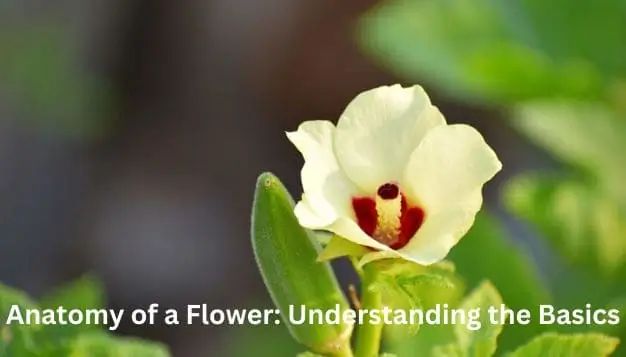Flowers, with their vibrant colors and intricate structures, have captivated human beings for centuries. Beyond their aesthetic appeal, flowers play a crucial role in the plant kingdom, serving as reproductive organs that enable plants to produce seeds and ensure the continuation of their species.
By understanding the anatomy of a flower, we can better appreciate the critical roles that flowers play in plant reproduction, ecology, and human use.
The anatomy of a flower is essential not only for botanists and horticulturists but also for anyone with an interest in the beauty and complexity of the natural world.
I. The Basic Structure of a Flower
A. Peduncle:
Every flower begins its journey with a stem known as the peduncle. This part supports the entire structure, connecting the flower to the main plant. The length and strength of the peduncle can vary depending on the type of flower and its environmental conditions.
B. Receptacle:
At the top of the peduncle lies the receptacle, a swollen, cup-shaped structure that holds the other parts of the flower. The receptacle provides a platform for the essential reproductive components to develop.
C. Sepals:
The outermost layer of a flower consists of sepals, which are often green and enclose the unopened bud. Sepals serve as protective structures, shielding the delicate inner parts of the flower from environmental stressors such as pests and harsh weather conditions.
D. Petals:
Petals are perhaps the most visually striking part of a flower, displaying a wide range of colors and shapes. Their primary function is to attract pollinators, including bees, butterflies, and birds, through their vibrant hues and often sweet fragrances. The arrangement and number of petals can vary widely among different plant species.
II. Reproductive Structures
A. Stamens:
Stamens are the male reproductive organs of a flower, consisting of two main parts—the filament and the anther. The filament is a slender stalk that supports the anther, where pollen is produced. The anther is critical for the release of pollen, which contains the male gametes necessary for fertilization.
B. Carpels:
Carpels, or pistils, are the female reproductive organs of a flower. Each carpel typically comprises three main parts—the stigma, style, and ovary. The stigma is the sticky, receptive surface that captures pollen, while the style connects the stigma to the ovary. The ovary contains ovules, which are potential seeds.
III. The Process of Pollination
A. Definition and Types:
Pollination is the transfer of pollen from the anther of a stamen to the stigma of a carpel, facilitating fertilization. There are two primary types of pollination—self-pollination, where pollen is transferred to the stigma of the same flower, and cross-pollination, involving the transfer of pollen from one flower to another.
B. Agents of Pollination:
Various agents contribute to the pollination process, and they include wind, insects, birds, and even mammals. Wind-pollinated flowers often lack showy petals but produce large quantities of lightweight, easily transportable pollen. In contrast, insect-pollinated flowers tend to have bright colors, sweet scents, and nectar to attract their pollinators.
IV. Fertilization and Seed Formation
A. Germination:
Once the pollen has successfully reached the stigma, it begins to grow a tube down the style, ultimately reaching the ovary. This process, known as germination, allows the male gametes to travel to the ovules within the ovary.
B. Fertilization:
Fertilization occurs when a male gamete fuses with a female gamete inside the ovule, forming a zygote. This marks the beginning of seed development. The fertilized ovule transforms into a seed, while the ovary develops into a fruit, protecting and aiding in the dispersal of the seeds.
V. The Role of Flowers in Plant Life Cycle
Understanding the anatomy of a flower is integral to comprehending the life cycle of flowering plants. Flowers enable plants to reproduce and ensure genetic diversity within a population. The process of pollination, fertilization, and seed formation contributes to the survival and adaptation of plant species in diverse environments.
Conclusion
In conclusion, the anatomy of a flower is a fascinating and intricate subject that unveils the mysteries of plant reproduction. From the protective sepals to the alluring petals, and from the essential stamens and carpels to the complex process of pollination and fertilization, each component plays a crucial role in the life cycle of flowering plants.
By delving into the basics of flower anatomy, we gain a deeper appreciation for the beauty of nature and a better understanding of the delicate processes that sustain life on Earth.

